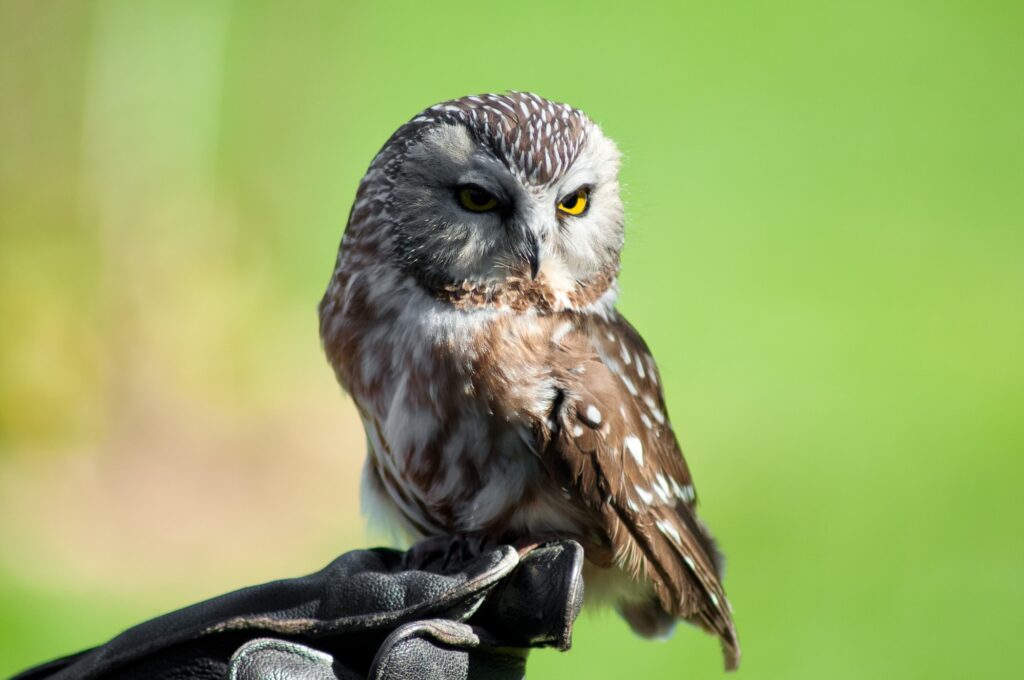Delaware, also known as the First State (because it was the first of the original 13 colonies to ratify the United States Constitution), is home to about 420 species of birds, and although the blue hen is the state’s official bird, there is a wide variety of birds to observe, including eight different species of owls.
Four of these owls are year-round residents, so it’s quite common to find nesting boxes set up by the state to help the wonderful birds breed safely.
If you’re a big fan of owls who hopes to observe all eight species of owls in Delaware, read on; we’ll tell you all about them below!
Eastern Screech-Owl
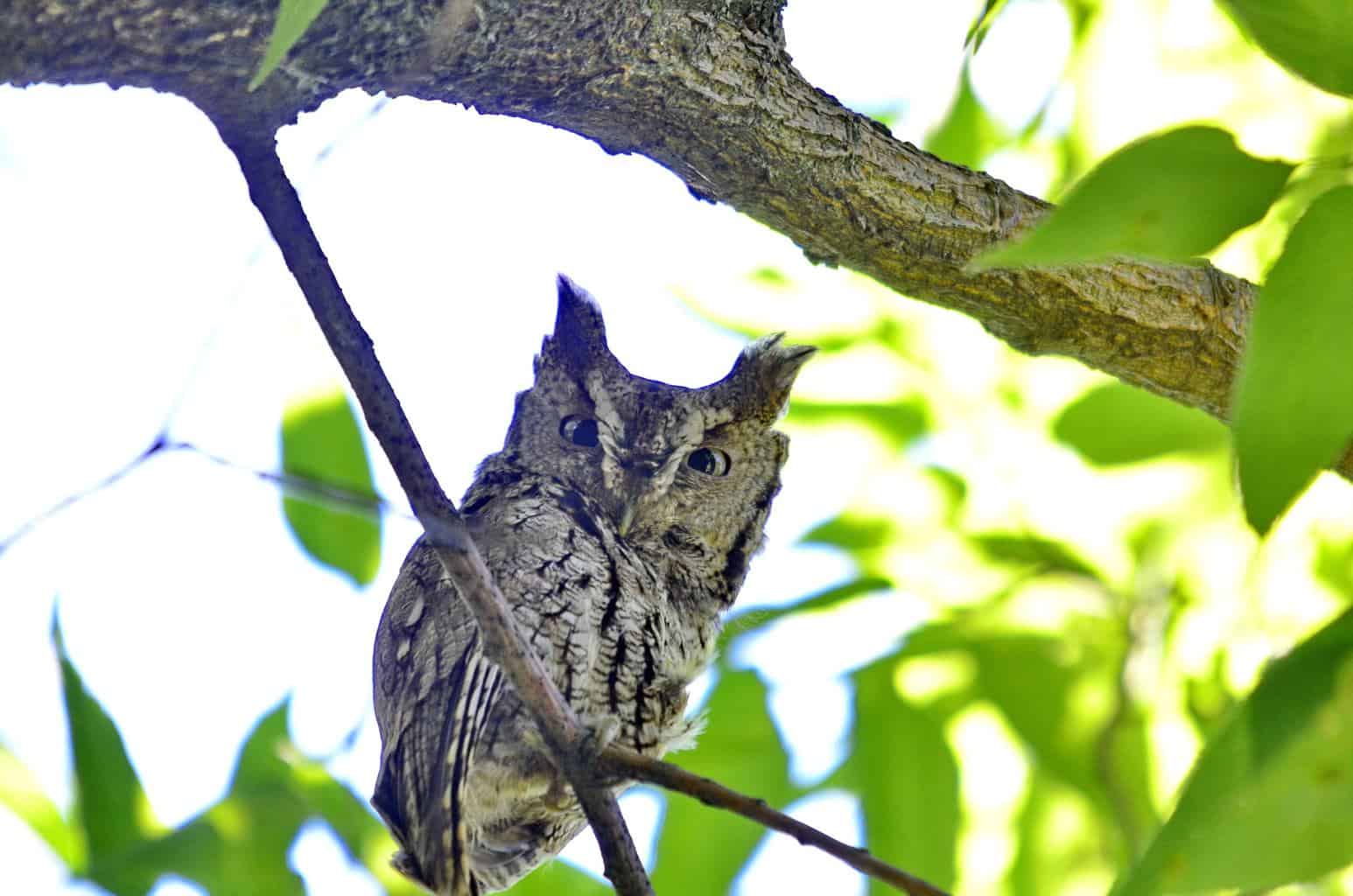
- Scientific Name: Megascops asio
- Length: 6.3-9.8 inches
- Weight: 4.3-8.6 ounces
- Wingspan: 18-24 inches
The eastern screech-owl has a grey or reddish body with several complex patterns that help it stay camouflaged as it hides against the tree bark. The owl has bright yellow eyes and can be seen in all types of forests, and its stocky body, oversized head, short wings, and almost no neck are easy identifiers for the bird.
The owl also has raised ear tufts and a distinctive call that make it easy to spot at night. Females of this species don’t leave the nest and feed on the food the male brings.
Blue jays usually call other birds to notify them when a screech-owl’s nearby, and in addition to songbirds, it feeds on earthworms, crayfish, insects, frogs, and lizards. If the prey is too big, the owl stores some of its food in tree cavities.
Great Horned Owl
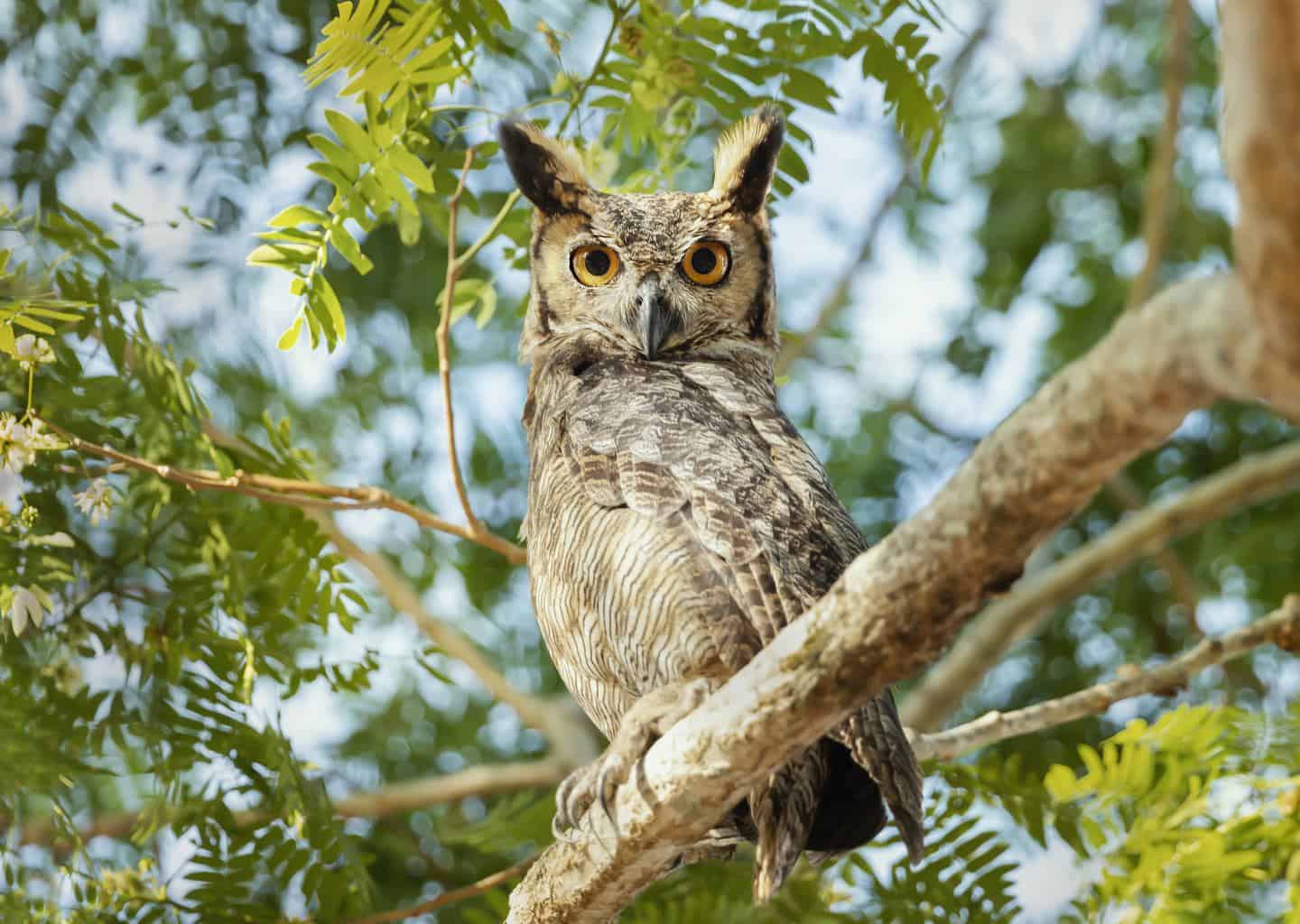
- Scientific Name: Bubo virginianus
- Length: 17-25 inches
- Weight: 32-88 ounces
- Wingspan: 36-60 inches
You’ve likely heard of the next bird on our list, as it’s considered one of the most common owls in North America. Known for its mottled grey-brown body and reddish face, the great horned owl has earlike tufts that can be sooty or pale, depending on the color of its plumage. It’s a nocturnal bird that can be seen perching on tree limbs at dusk and night. You’ll find it using its broad wings to soar through young woods or open areas, as it’s highly adaptable.
The owl’s call is deep and made up of a series of several hoots, and the bird is a fierce predator who hunts other predators, including other owls. However, it also likes to feed on smaller animals like rodents, frogs, and scorpions, and thanks to its weak sense of smell, you may also find these owls chowing down on skunks!
You might say it’s the American crow’s biggest nemesis, as flocks of these birds usually gather to try to make the great horned owl fly away, as it’s their most dangerous predator.
Snowy Owl
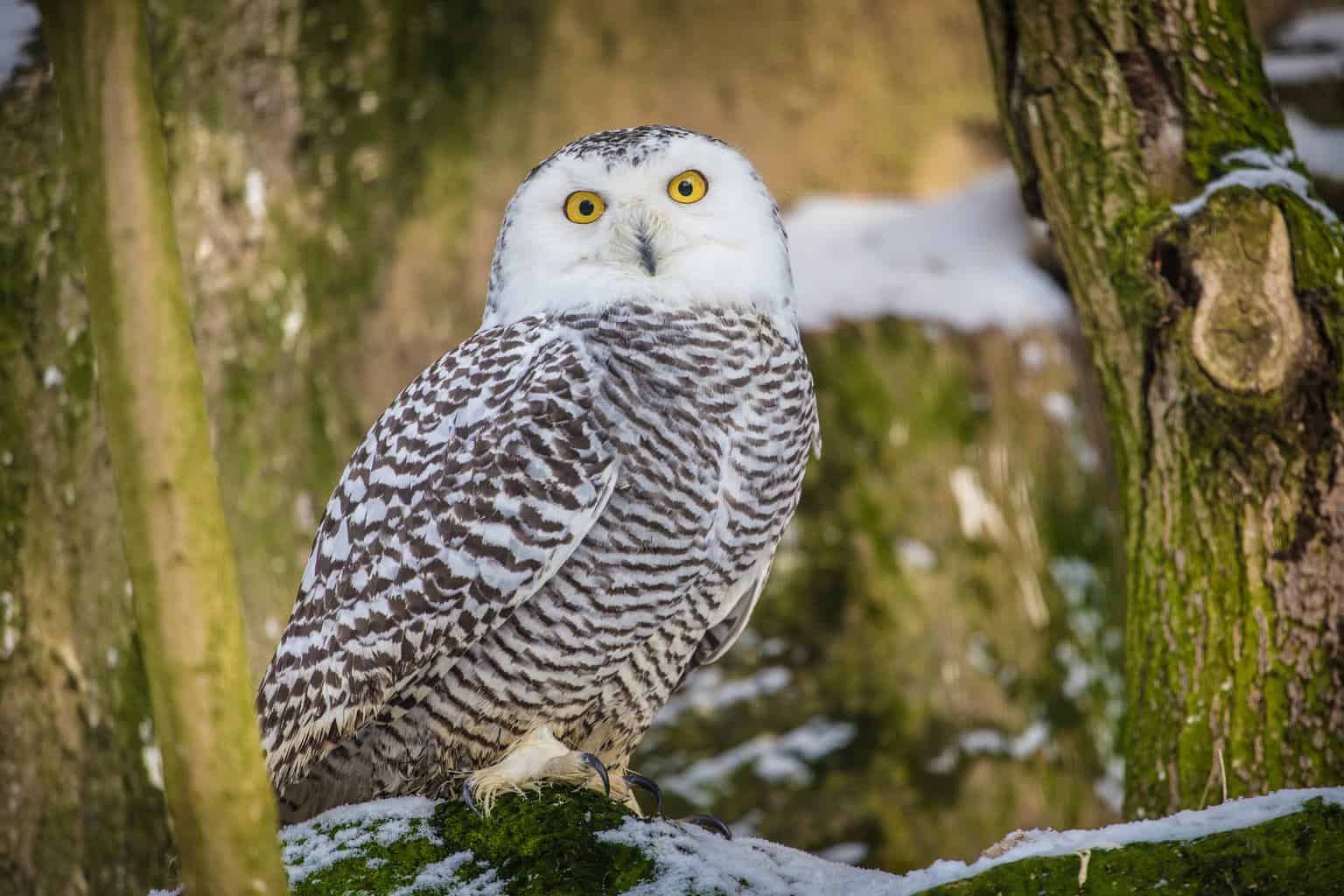
- Scientific Name: Bubo scandiacus
- Length: 20-25 inches
- Weight: 2.9-5.5 pounds
- Wingspan: 46-65 inches
Even if you’re not an avid birdwatcher, the snowy owl (also called an arctic owl) is likely to attract your attention thanks to its rather distinctive appearance. It has a catlike face, bright yellow eyes, and is large — in fact, it’s one of the biggest owls in the whole world.
Its feathers are mainly white, but it sports a few black and brown markings. The amount of markings differs between birds, so females usually have more, giving them a salt-and-pepper look.
Most of the time, people mistake this owl for a dirty snowball, especially when it’s sitting on the ground. It likes to perch on telephone posts, building tops, and hay bales, and as the owl ages, its feathers become whiter and paler.
Because it lives close to the arctic region, the snowy owl is diurnal and doesn’t mind looking for prey in the 24-hour daylight climate. As far as nesting is concerned, you can find this species building its nest on the ground. The male usually selects the region, and the female narrows down the exact location and builds the nest by pressing its body into the ground and scraping out the hollow spot.
When it begins to get hungry, you’ll find the snowy owl feeding on lemmings and waterfowl. It’s an agile bird, so it can catch other birds as they fly through the air.
Burrowing Owl
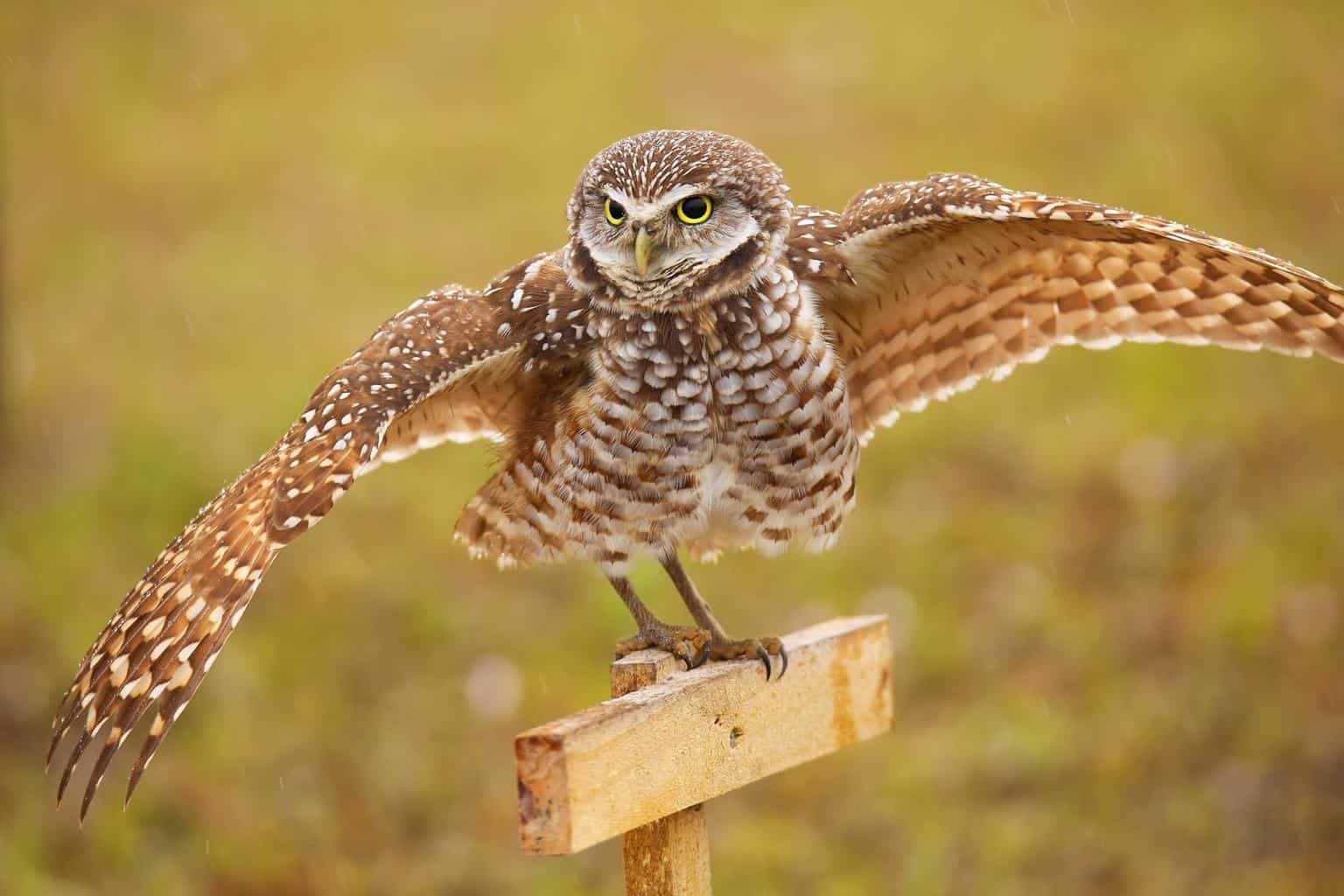
- Scientific Name: Athene cunicularia
- Length: 7.5-11 inches
- Weight: 4.9-8.5 ounces
- Wingspan: 20-24 inches
The burrowing owl is a rather small bird with a sandy-colored plumage, dark brown bars on its chest, and bright yellow eyes. It also sports a rounded head and has no ear tufts like other owls. Unlike other species, male and female burrowing owls are the same size.
Owls of this species spend most of their time on the ground or fence posts, and they’re more likely to hunt during the daytime and stay close to the ground as they look for something to eat.
Burrowing owls live in open areas, like prairies and pastures, and you can find them if you pay close attention to ground squirrel colonies, as the bird will likely use their already-dug burrows to nest. A spotting scope for birding will help you, as the owl is rather small and incredibly camouflaged in the wide-open area where it’s likely to live.
Barred Owl
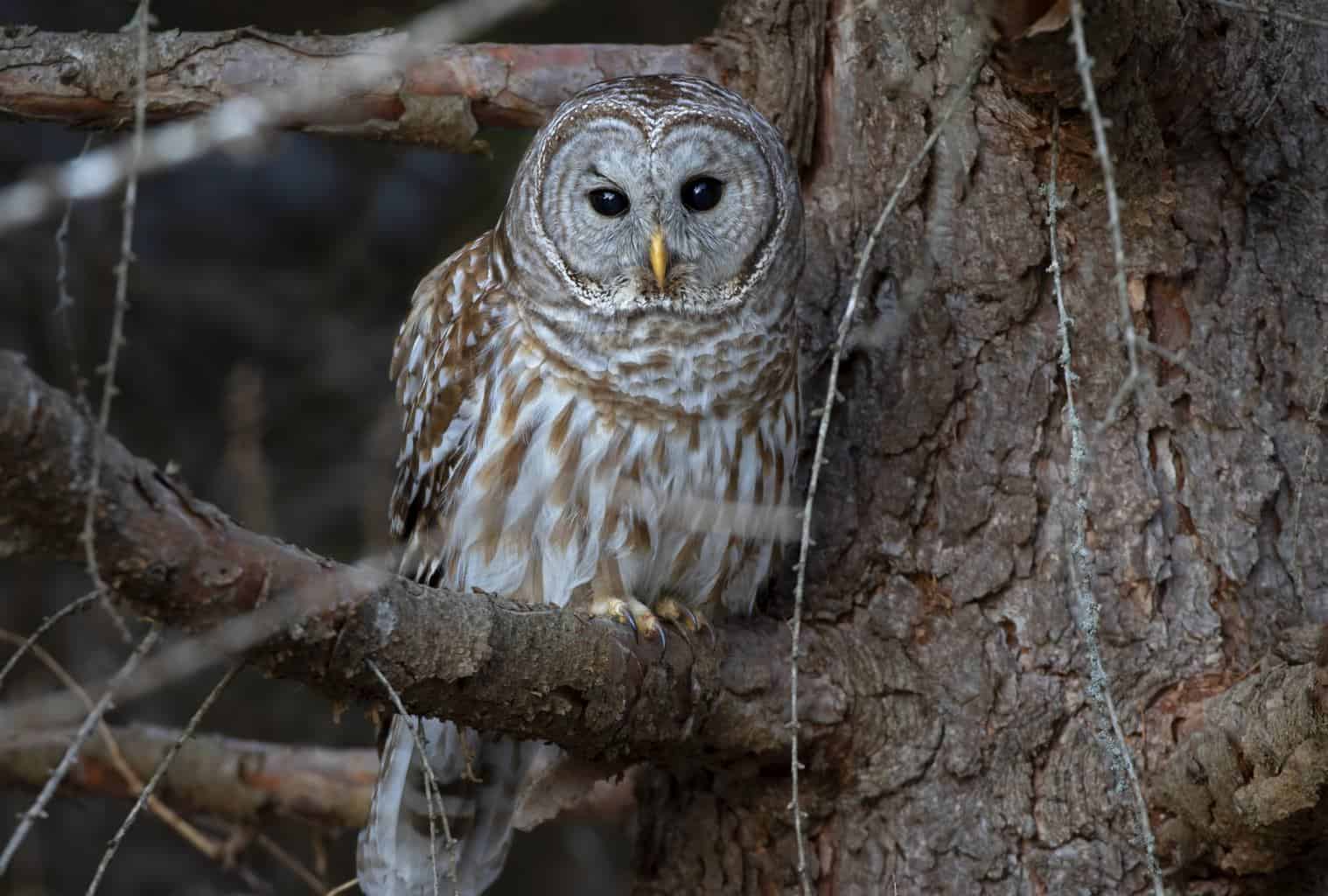
- Scientific Name: Strix varia
- Length: 16-25 inches
- Weight: 16.6-37 ounces
- Wingspan: 38-49 inches
Although the barred owl has a distinctive hooting call, it usually remains pretty silent and unnoticed while looking for prey. Its feathers are mottled brown and white with brown-marked underparts and dark brown or almost black eyes, and its wing feathers have brown and white bars.
Barred owls usually live in mature forests, especially near water, and they’re a lot easier to hear than to see, especially at night. During the day, the owl will snooze on tree limbs, but if you’re lucky, you might hear it let out a hoot or two. Try to imitate its call, and wait for a curious barred owl to come to investigate you.
This bird of prey prefers to eat mice, chipmunks, squirrels, voles, and even small birds and frogs, but the fierce hunter isn’t immune to predators itself; as it flies through the woods, it has to steer clear of one of its most dangerous attackers, the great horned owl.
Long-Eared Owl
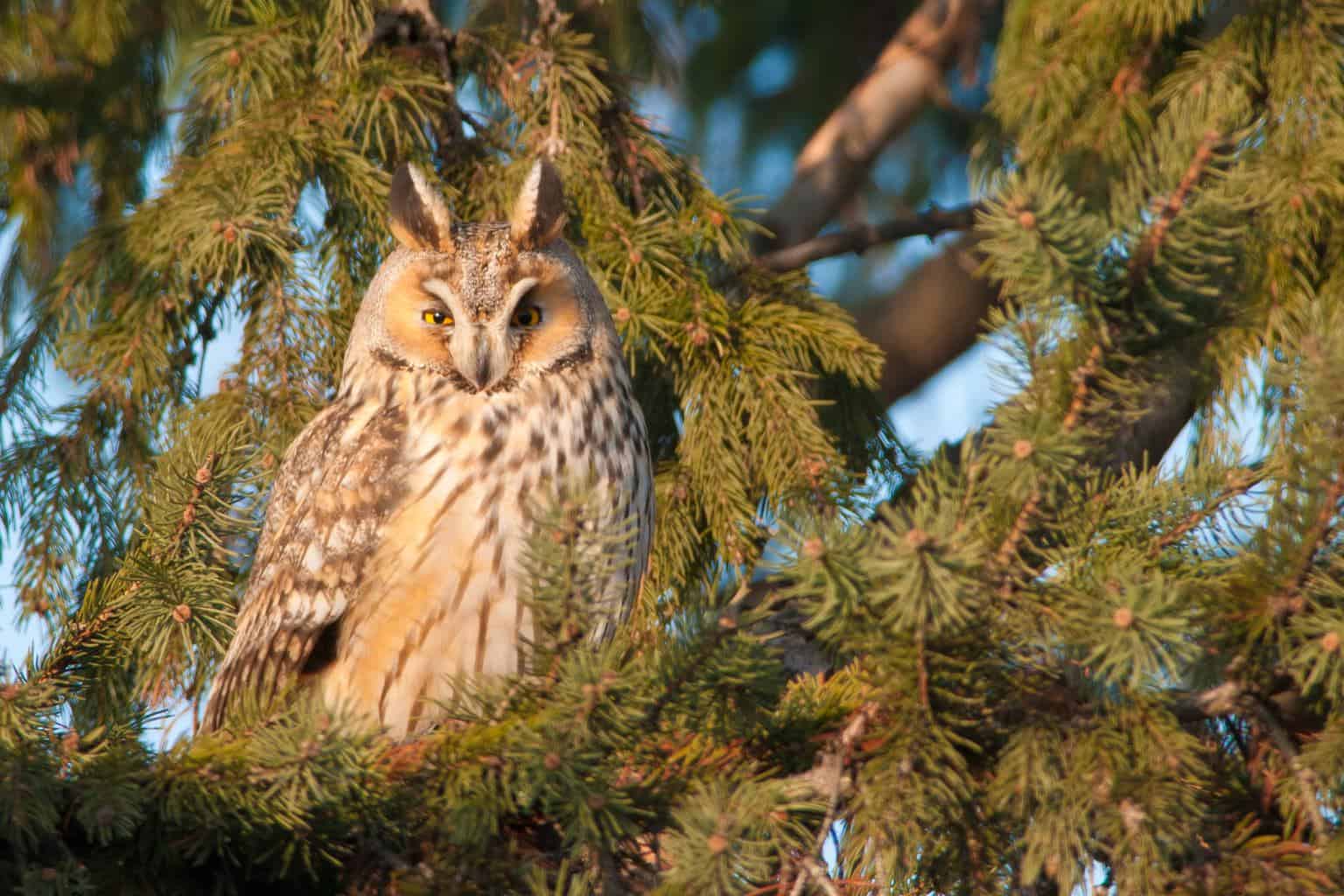
- Scientific Name: Asio otus
- Length: 12-16 inches
- Weight: 7.8-15.3 ounces
- Wingspan: 34-40 inches
Next up on our list of birds of prey in Delaware is the long-eared owl, a medium-sized, dark bird with an orange face and yellow eyes. Its ear tufts are black with buff or orange-colored fringes that point up like exclamation points. This owl’s plumage makes a great camouflage, so it will be hard to find.
This owl is nocturnal and spends most of its time roosting in the dense parts of trees, but its long, low hoot can be heard from as far as 0.7 miles away. In most cases, the long-eared bird nests in abandoned squirrel nests, tree cavities, and stick nests left by other birds, but it’s also been known to use artificial baskets and open-fronted nest boxes.
Find birds of this species eating small mammals and rodents, like mice, kangaroo rats, rabbits, and small birds that might be on the ground.
Short-Eared Owl
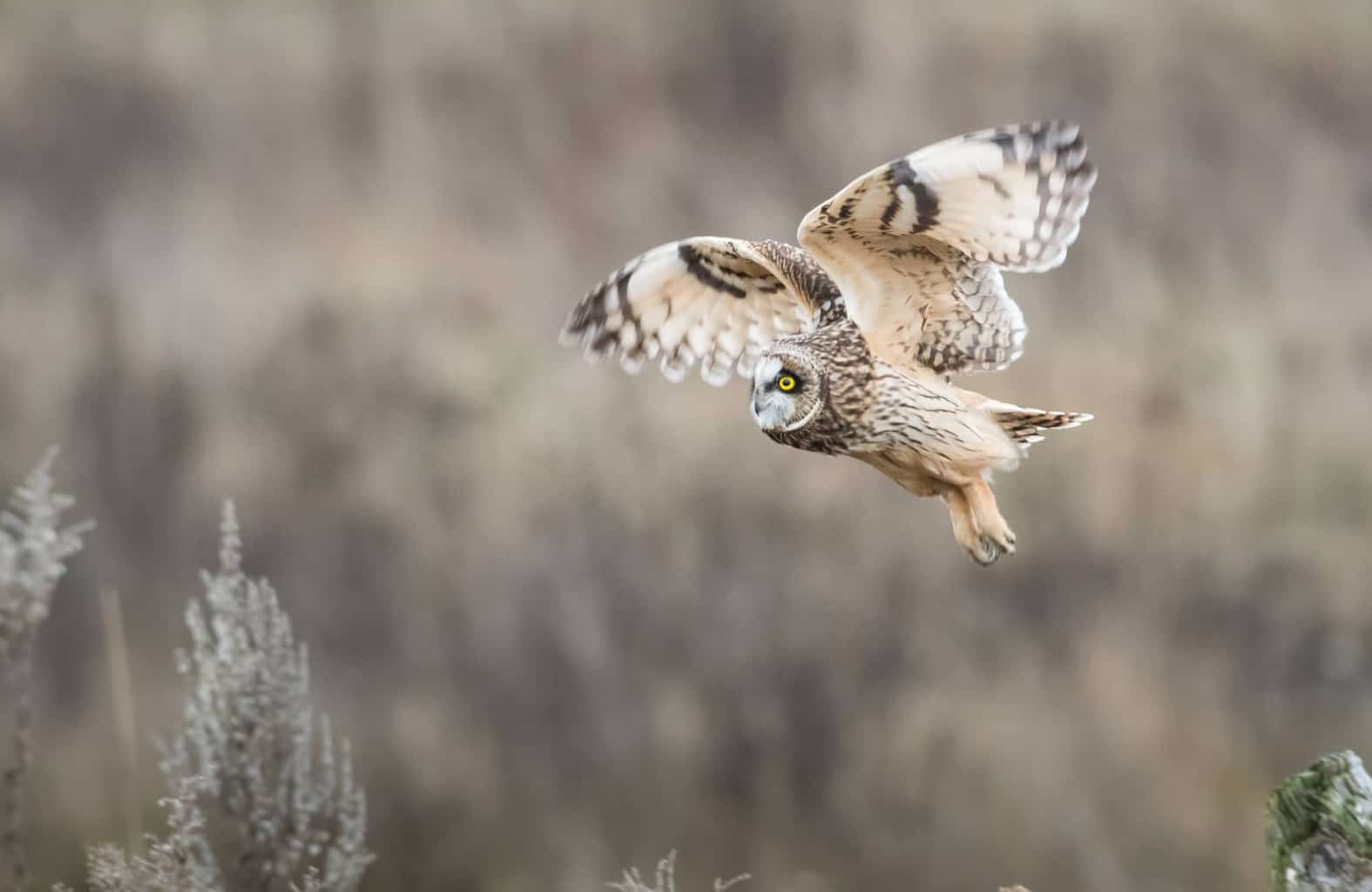
- Scientific Name: Asio flammeus
- Length: 13-17 inches
- Weight: 7.3-16.8 ounces
- Wingspan: 33-43 inches
The short-eared owl is a medium-sized bird with a rounded head and small ears that are difficult to detect. It has a brown body with spotted buff and white underparts, a heavily streaked breast, and yellow eyes that are highlighted by black outlines. You’ll also recognize this bird’s short tail and broad, rounded wings.
This secretive bird hunts during the daytime — usually at dusk and dawn — and flies silently and close to the ground. It uses its acute hearing to locate small animals like moles, mice, shrews, rats, weasels, and bats.
Find the short-eared owl living in open areas with low vegetation; think meadows, coastal areas, marshes, and agricultural spaces.
Northern Saw-Whet Owl
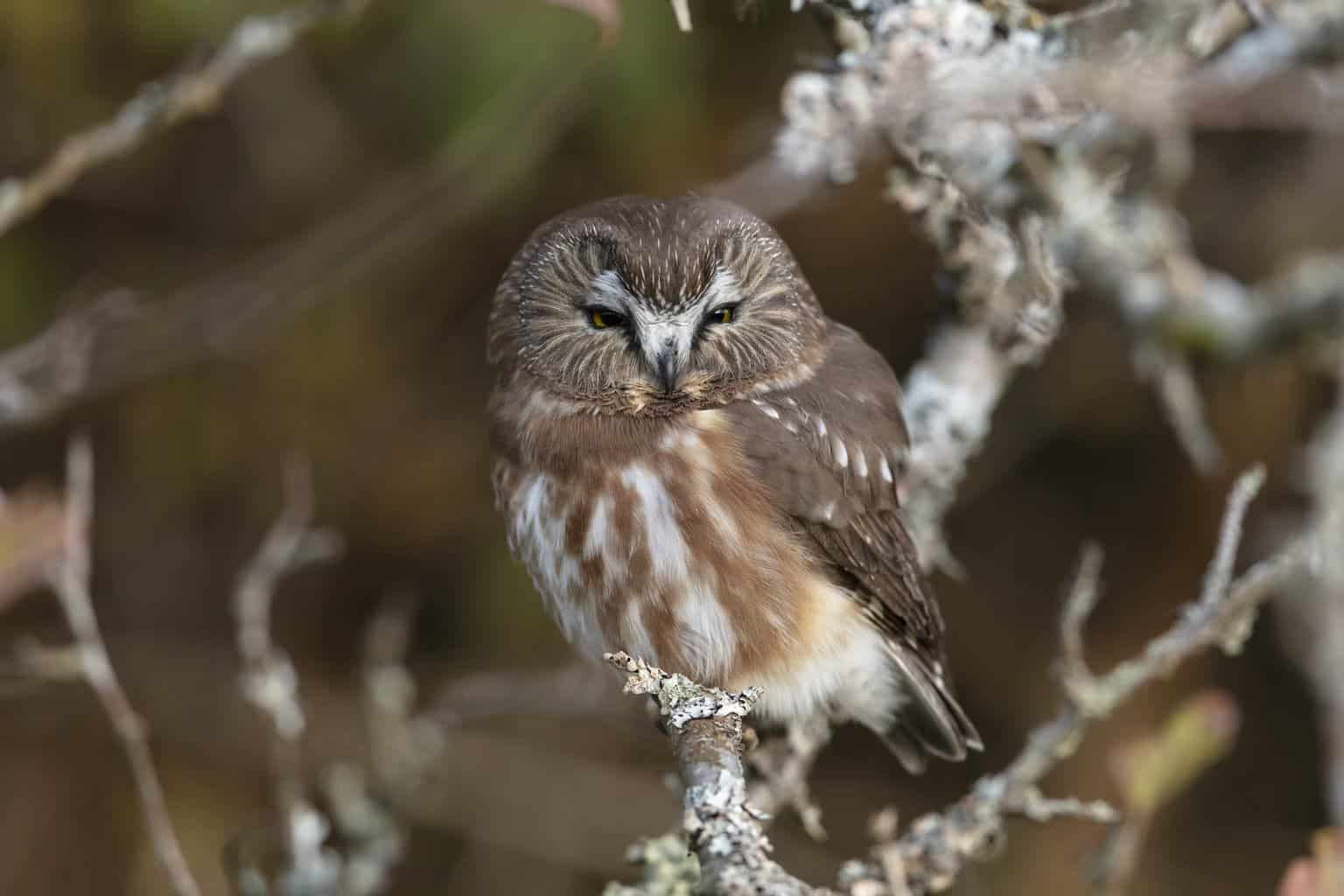
- Scientific Name: Aegolius acadicus
- Length: 6.7-8.7 inches
- Weight: 1.9-5.3 ounces
- Wingspan: 16.5-22.2 inches
The northern saw-whet owl is a small bird with a large head. It’s usually mottled brown with a whitish facial disk and yellow eyes.
This owl may have gotten its name from the sound of a saw as it gets sharpened on a whetting stone, which resembles this owl’s call. The bird is nocturnal and quite hard to see, but this shrill cry announces its presence in mature forests where it usually roosts on branches above eye level during the day.
It mainly feeds on deer mice, white-footed mice, voles, bats, and young chipmunks and squirrels. In some cases, the owl might supplement its diet with songbirds, smaller owls, and some insects. In most cases, songbirds can help you locate this owl, as they will caw and fly at a roosting northern saw-whet owl until it flies away.
Wrap Up
Although there are only three state forests and one national park in Delaware, the state’s still an interesting place for birdwatchers, as there are multiple bird species for you to find and study.
Owls can be found in multiple locations in Delaware, and you can also attract a breeding pair to your backyard by setting up a nesting box. Just make sure the nest’s opening is properly guarded to protect the eggs and young owls.

